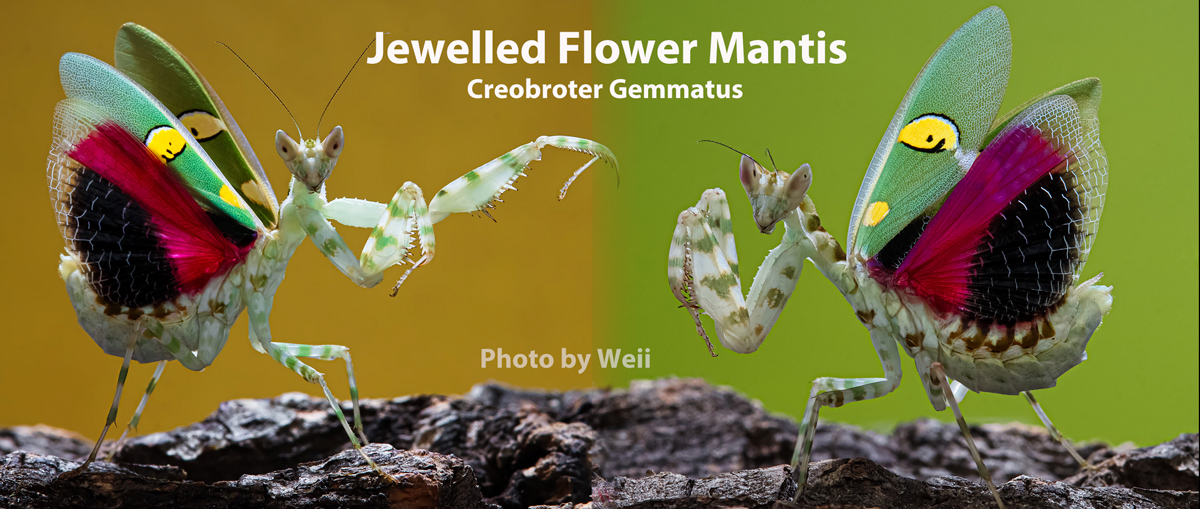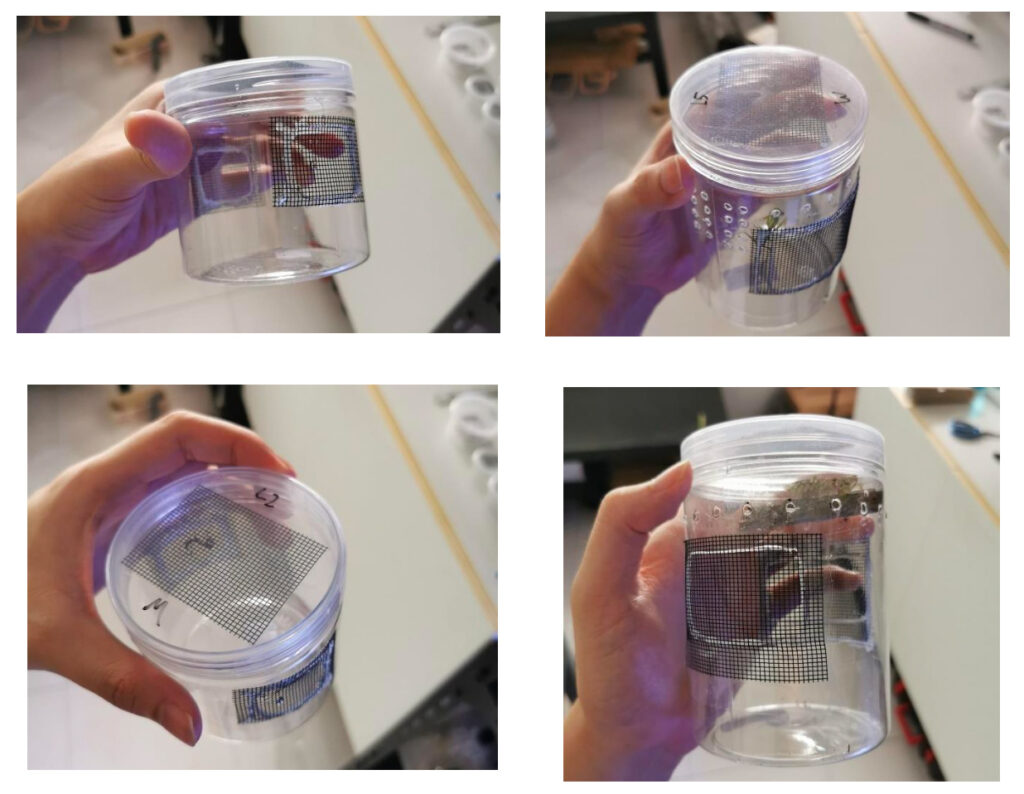Praying Mantis Hobby
Care guide for Orchid and Jewelled Flower Mantis
written by YT & Lance Lee, photos by YT & Nickname Weii

Either catch your own mantis in the wild, or get from reputable breeders such as Benjamin Walter Cutler & Nickname Weii
If you are new to the hobby, consider the Jewelled Flower Mantis (Creobroter Gemmatus) first. While they are small, they are fun and more hardy than other mantis species.
After gaining some experience, you can try keeping the beautiful but more vulnerable Orchid Mantis (Hymenopus Coronatus )

Both Jewelled and Orchids are flower mantis species that can be found locally in Southeast Asia. Both are forest dwelling but are rarely seen in the wild nowadays. Efforts are being made to restore their numbers in the wild.
They are smaller types of mantis with adults growing up to 4cm (1.6 inch) for Jewelled Flower Mantis) and up to 8.5cm (3.5 inch) for Orchid Mantis.
For Jewelled Flower Mantis, the adults are usually white with green and brown bandings across the whole body and legs. Their wings are green in color with a ‘smiley face’ patterning on the top, underneath there is also a pair of purple wings that only show before they take flight or when they feel threatened. Males are slightly smaller than females but they have longer wings.
For Orchids, the adults are white with pink accents, and their legs have lobes resembling orchid petals.
Compared to Jewelled Flower Mantis, Orchid Mantis males are significantly smaller than the females.
Care requirements
Enclosure size
You can make an enclosure using any plastic or acrylic containers.
The enclosure’s height should be at least 3x the length of mantis, and enclosure’s width at least twice the manti’s length.
This height requirement is important because mantis molt to grow bigger. To molt, mantis will hand upside down and squeeze themselves out of their old skin/shell. Insufficient height will complicate this molting process.
Mismolts will lead to mantis deformaties and deaths.
Once the mantis reach adulthood, they stop molting and you can make do with 2x mantis’ height for enclosures.
The top of the enclosure should have gripping materials to help them hang upside down, such as: Mesh, Corkbark, Cork stickers, dried branches. If you are buying those commercial-made enclosures for reptiles, replace the metal wire mesh with plastic or fabric ones to protect your mantis’ claws.
We recommend that you DIY your own mantis enclosure using plastic containers. Refer to the pictures below.
Read more about Mantis Enclosures

Note that mantis are cannibalistic in nature. They will kill and eat their own kind.
The nymphs in the pictures above are newborn L1 mantis, so it is still OK to keep them together. Once they start molting, you should separate them. Those who have just molted will be vulnerable to attacks by the others.
Molting
Important to know when your mantis is molting, as that is when they are most vulnerable.
Bad mis-molts can lead to mantis death.
Just before molting, your mantis may suddenly be rejecting food and hanging upside down with arms slightly stretched out and abdomen pointing downwards for hours. That is a telltale sign.
Make sure that live feeders are not left uneaten when your mantis molts, as they may attack your mantis when it is vulnerable.
It is important you do not disturb the mantis when it molts as they are at their most fragile state, a small bump or fall can injure or possibly kill the mantis.
Being a local species, jewelled flower mantis and orchid mantis do not need extra care to molt in our southeast asian climate. In dryer climate, make sure there’s enough humidity.
Flower mantis are fairly fast growers so when young, if you feed more frequently, they may molt every 1-3 week up to L4. From L5 onwards, they will take much longer to prepare for their next molts.
What to do with the molts?
You can keep them or discard them, it is just the exoskeleton of their previous size.
Stages of growth
Instars refer to the stages of their life. We determine them by L1, L2, L3 and so on, newborns start at L1, after a molt they will become L2, another molt then L3, etc.
Male jewelled flower mantis and orchid mantis turn adult at L7 and females at L8 ( though there are instances that females skip from L6 to L8)
Below picture shows a newborn orchid mantis at L1, see how different it looks compared to the adult (see image earlier)

Feeding and Watering
Like all critters, mantis need food and water too.
Their diet varies as they grow. In captivity, we feed mainly feed them cockroaches, crickets and fruitflies(for younger/smaller mantises). For jewelled flower mantis and orchid mantis, they require fruitflies at L1.
From L2 onwards, they are able to take pinhead crickets/baby roaches. As they grow in size, you can increase the feeder amount or size accordingly.
Where do I get feeders?
There are a lot of feeder breeders in Singapore, you can find them in the facebook mantis groups or though recommendations from existing hobbyists, usually there will be one near your area! Your seller should advise how to keep your feeders too, a healthy feeder = a healthy mantis.
How much to feed?
Usually I feed mine one per day and continue until their abdomen seems fat enough then I stop for a day or two until the abdomen seems smaller before feeding again. A good measurement is the amt/size of feeder should be 2x the abdomen size when it is flat.
How often to water?
Mantis DO drink water. You can use a small water bottle spray to mist the enclosure’s sides once or twice a day.Join our community of Mantis Keepers
whatsapp Lance at +85297718818 or add him via telegram @memepapa
…
…
…
…
…
…
…
…
…
…
…
…
resources
More coming soon
…
- Interact with fellow hobbyists
- Show your mantis.
- Experience the fun of mantis


mantis mantis mantis
- A series of in-depth articles.
- breeding tips
- trade mantis
“Études has saved us thousands of hours of work and has unlocked insights we never thought possible.”
Annie Steiner
CEO, Greenprint
Watch, Read, Listen
Join 900+ subscribers
Stay in the loop with everything you need to know.